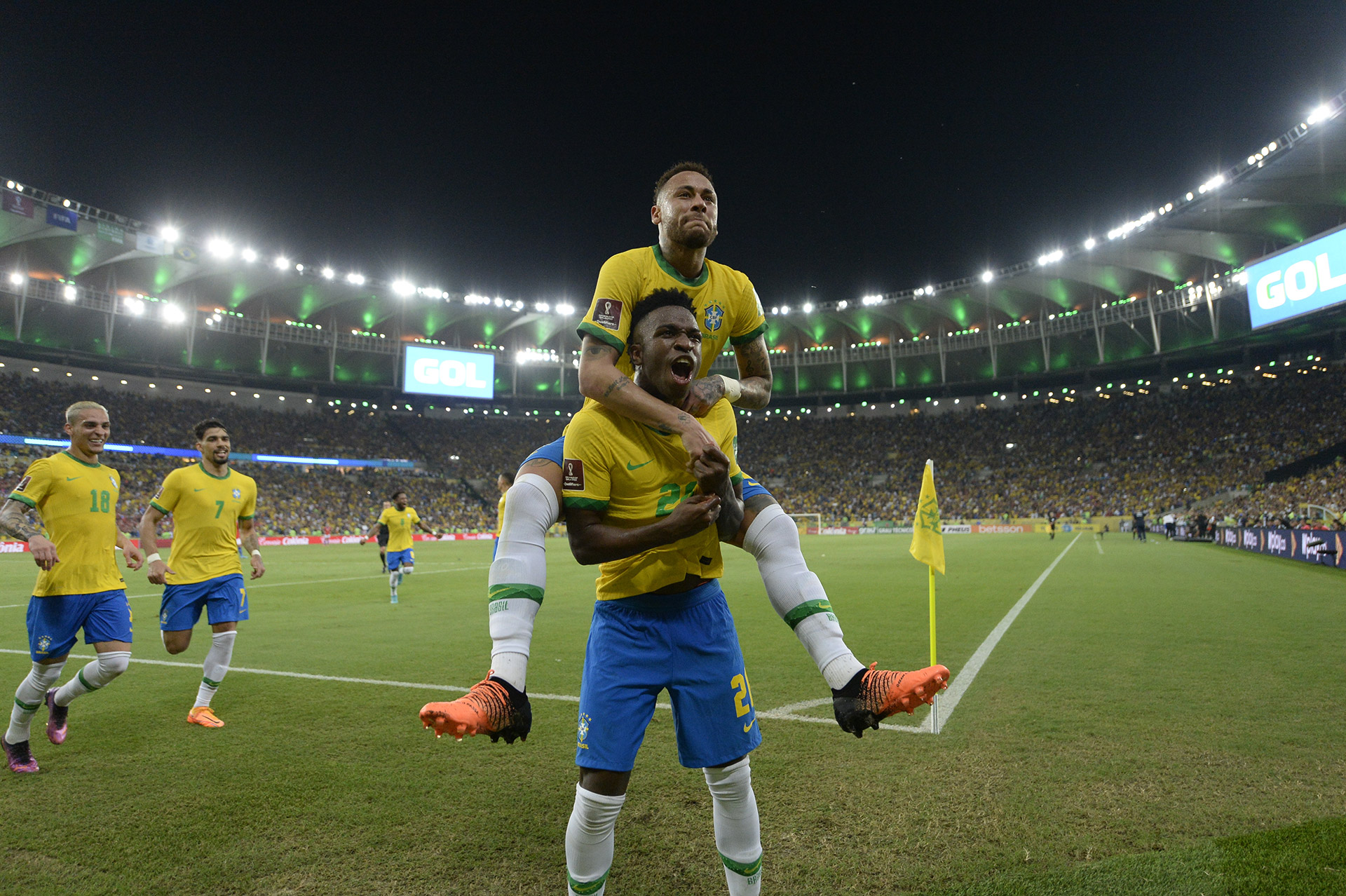“Racism is Normal”
“This organization is an organization that clearly wants to fight against racism, as it already has done.” Javier Tebas was referring to La Liga Nacional de Fútbol Profesional, Spanish football’s governing organization, of which he is president. His declaration was a response to the Brazilian player Vinícius Júnior’s stunning claim, “Racism is normal in La Liga.”
It was a predictable statement after a public dispute between Tebas and Vinicius: The player’s assertion that the Spanish league “belongs to the racists” was met with “La Liga has worked and will continue to work against this behavior of xenophobia and racist comments in stadiums.” Vinícius later called on sponsors and broadcasters to put pressure on the league to make changes. The results of this remain to be seen.
Spain is not completely alone in the 30 or so European football playing countries that lie east of Poland. Italy’s Ultras have rightwing and nationalist leanings and Inter Milan’s black Belgian player Romelu Lukaku was targeted by racist abuse in Turin recently. But racism has largely disappeared from western football. At least, from football crowds. In England, Tottenham’s South Korean forward Son Heung-min was the subject of a racist online video. The sources of online content are notoriously difficult to trace and it’s doubtful that the originators of this or other hateful messages circulated online are sports fans: More likely malevolent geeks who want to bring sports into disrepute.
History of Football Racism
The persistence of racism in association in football is one of the most perplexing anachronisms in sports, or any other sphere of society for that matter. Like the game itself, the practice of abusing black players has its origins in England. In the late 1970s, the appearance of dozens of black players enraged many white fans who reacted by hurling bananas, grunting like apes, and screaming epithets. The players were the children of Caribbean migrants who had settled in the UK in the aftermath of the second world war (often known as the “Windrush generation,” after the name of the first vessel to have arrived in England from Jamaica in 1948).
It was unexpected: at various intervals in history, black players had appeared in English football without incident, and the Afro-Brazilian player Pelé was acknowledged as the best in the world. But, coaxed by far right political movements, many fans were reminded that football was created by white men, watched by white men and run by white men. Blacks were uninvited guests. I recall talking to Cyrille Regis (1958-2018), who played for West Bromwich Albion and other clubs in the period. He told me how he learned to “absorb,” as he put it, the near-continuous abuse and somehow used it to motivate him.
Vile as it was, the racism was intelligible: White fans resented the intrusion of people they considered interlopers in a sport they and their forebears built and owned. Or at least felt they owned. There were underlying conditions too: Unemployment was prodigiously high in Britain in the late 1970s and early 1980s. In 1981, a barely believable 31% of employable under-18-year-olds were out-of-work. Far right groups blamed ethnic minorities, of whom Caribbeans and their descendants were about half (total number in UK population about 500,000, or less than 1%).
Theories of Racism
Theories of racism differ, but most are predicated on competition for scarce resources, including jobs, accommodation, healthcare and education. There is nothing inevitable, less still natural about racist antagonism, and rivalries over resources are arbitrarily created from convenient markers. Migrant status, visible appearance, language, cuisine, and patterns of worship serve as metaphorical signs of enemies. What appears to be conflict emanating from spurious “racial” differences has more prosaic origins.
Racism, in common with other cultural practices, is volatile: It’s like fire — a blast of wind and it spreads uncontrollably and unpredictably. That’s what happened after football fans around the world discovered English fans’ extraordinary way of barracking players. Once started, fires take on a life of their own. Racism died down in most parts of Europe by the late 1980s: The emergence of so many illustrious black players in the sport’s top leagues silenced abusive fans in most of western Europe, though not in the east.
Football in places like Ukraine, Poland and Russia today is, in terms of cultural diversity, about where Britain was in the mid-1980s. Unlike Britain and other western European nations, which have endured the tortures of the damned trying to extirpate or even just manage racism, eastern European countries regard racist abuse just like other forms of football taunting based on physical appearance. They don’t seem to grasp the severity of their abuse. Or, if they do, their governments don’t.
I won’t labor the history of racism in football. Suffice it to say that somehow it has survived in a world where black lives matter and multiculturalism has been elevated to sacrosanctity. Survived, that is, in certain forms. As I argued earlier, the form popular in most European countries is via social media and this means sports fans are not necessarily involved. The shouting has gone. Suppressed perhaps, but, as long as racism isn’t expressed in behavior (verbal and nonverbal), its effects are manageable. We’ll have to accept that Eastern Europeans will take longer to catch up. But that still leaves us with Spain. Why is it such an outlier?
Almost 20 years ago, Spain’s national team manager Luis Aragonés described Thierry Henry, a French player, as “negro de mierda [black shit].” The manager was widely condemned, but the fact that a person of such seniority felt comfortable casting such a foul slur made football wonder if the Spanish were out-of-step with the rest of Western Europe. The recent misadventure suggests they still are. Perhaps Spain, with its various regional cultures and languages, including Catalan, Basque, Galician, and Valencian, has assimilated or at least learned to live with strains and enmities related to identity and regional autonomy, particularly in Catalonia and the Basque Country. One of the effects may be to have desensitized the Spanish to the pain occasioned by divisive language.
Sledgehammer-To-Crack-A-Nut
So, what should be done? We can’t get into people’s heads and change their thoughts. But we can prevent them from talking and acting in a way that gives open expression to those thoughts. And, when they do, we should punish. The USA’s National Basketball Association (NBA) opted for the sledgehammer-to-crack-a-nut strategy when, in 2018, it hit Los Angeles Clippers’ owner Don Sterling with a $2.5m fine and an order to sell the club. Sterling had acknowledged during an interview with NBA investigators that he had made disparaging remarks about black people. The governing organization’s response appeared to be disproportionately punitive, but have you heard of any racism in basketball lately? (I’m not being naïve: it still manifests every so often: Kyrie Irving recently said crowds treat black players “like they’re in a human zoo.”)
Football has to make clubs culpable for their fans’ behavior. It already does this to an extent: Closing stadiums or parts of stadiums for periods and fining clubs indicates that governing organizations are prepared to lay blame at the door of clubs. Yet the penalties are hardly on par with the NBA sanction. Expulsion from a major European competition, double-digit points deductions and multiple transfer window freezes might ram home the message. These kind of chastisements would quickly translate into a cogent message for fans: Do it again and you’ll get more of the same! We would never hear another peep. And, if some errant sheep in the flock mouthed a racist remark, fellow members of the crowd would soon muzzle them.
This is suppression rather than resolution. It’s a reasonable ambition, not an unattainable or fanciful hope. I’ve learned over the years that thought control doesn’t work: Behavior control is altogether more practicable. It’s the paradox of football that the globally inclusive game is riven with a bigotry that should have been stillborn or, at least, died in the 1980s. In many parts of the world it has, but its persistence, especially in Spain, is a particular embarrassment. It’s a wonder football’s corporate sponsors like Coca-Cola, adidas, Toyota and Qatar Airways haven’t grown uncomfortable with the residual presence of racism and pressured governing organizations to crush it. Television networks too might have flexed their muscles and urged stiffer penalties for offending clubs — though, of course, they wouldn’t want to lose marquee clubs, or ratings would fall.
Racism will be crushed for sure. It remains a question of time: Football will, at some point, realize that the sledgehammer is a crude, heavy, powerful instrument designed to break rocks. Some nuts are tougher than others: For example, macadamia nuts have an extremely hard shell that requires significant force or specialized tools to crack open. A sledgehammer has more than enough force to crack that. The time for education and persuasion is over: football must now start hammering.
[Ellis Cashmore is co-editor of Studying Football]
The views expressed in this article are the author’s own and do not necessarily reflect Fair Observer’s editorial policy.
Support Fair Observer
We rely on your support for our independence, diversity and quality.
For more than 10 years, Fair Observer has been free, fair and independent. No billionaire owns us, no advertisers control us. We are a reader-supported nonprofit. Unlike many other publications, we keep our content free for readers regardless of where they live or whether they can afford to pay. We have no paywalls and no ads.
In the post-truth era of fake news, echo chambers and filter bubbles, we publish a plurality of perspectives from around the world. Anyone can publish with us, but everyone goes through a rigorous editorial process. So, you get fact-checked, well-reasoned content instead of noise.
We publish 2,500+ voices from 90+ countries. We also conduct education and training programs
on subjects ranging from digital media and journalism to writing and critical thinking. This
doesn’t come cheap. Servers, editors, trainers and web developers cost
money.
Please consider supporting us on a regular basis as a recurring donor or a
sustaining member.
Will you support FO’s journalism?
We rely on your support for our independence, diversity and quality.







Comment